
Kembalinya RIHGA Royal Hotel Kyoto
Japan TravelDengan dua fitur terbaru: Lantai Premium dan restoran istimewa.

The Saihoji Temple was founded during the Nara period, about 1300 years ago, by the priest Gyōki at the request of the Emperor Shōmu, along with forty-nine other temples of the Hosso sect.
In 1339, in the midst of the devastation of the post-war period, Musō Kokushi, then one of the most respected Zen priests in Japan, revived the temple as a Zen temple at the invitation of Fujiwara Chikahide (the chief priest of the Matsunō shrine).
The complex with an area of 35,000 square meters is now one of the special historical sites and places of scenic beauty in Japan and was included in the list of World Heritage Sites by UNESCO in 1994 as a historical monument of ancient Kyoto. Because of the beautiful moss that covers the area, it is now popularly known as Kokedera (moss temple).
5-minute walk from Kokedera Bus Stop

Dengan dua fitur terbaru: Lantai Premium dan restoran istimewa.

Staf, lokasi, dan kualitas fantastis - Hotel MyStays Kyoto Shijo
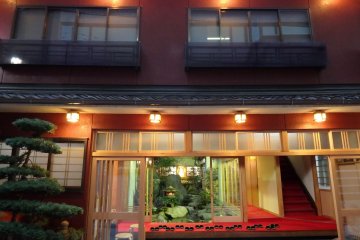
Tiga menit saja dengan berjalan kaki dari Kyoto Station, Nishikiro Ryokan adalah penginapan yang sederhana, bersih, dengan pemilik dan pengelola yang ramah. Sangat cocok untuk pelancong dengan budget terbatas yang mengininkan pengalaman otentik khas Jepang
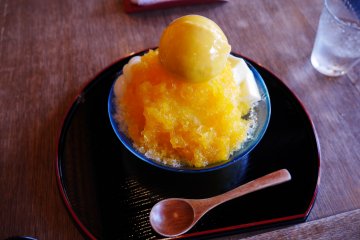
Ex Cafe, sering disebut juga Ickx Cafe, merupakan tempat makan yang indah, terletak di jalanan Arashiyama. Dengan beragam kakigori (es serut) yang enak dan kue roll yang unik, para pejalan kaki bisa berhenti sejenak untuk beristirahat dan mengisi tenaga untuk mengalahkan panasnya Kyoto.
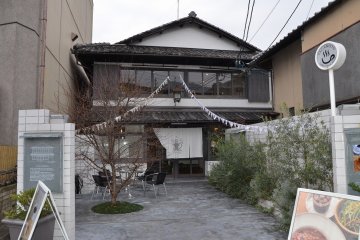
Se-abad sejak Sagano-yu dibangun sebagai pemandian umum pada tahun 1923, tempat ini telah menjadi tempat yang populer bagi penduduk setempat. Seiring waktu berlalu dan gaya hidup masyarakat berubah dengan lebih beragam, Sagano-yu menutupnya pintu untuk terakhir kalinya pada tahun 2004. Namun, pintu-pintu yang sama dibuka kembali untuk umum sebagai direnovasi, modern kafe dan saat ini menikmati popularitas baru.

Kedai soba berdiri dengan beragam menu lezat serta harga yang sangat terjangkau yang dapat ditemui di pusat kota Kyoto.
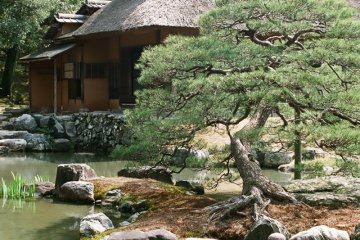
The Katsura Imperial Villa, or Katsura Detached Palace, is a villa with associated gardens and outbuildings in the western suburbs of Kyoto, Japan. It is one of Japan's most important large-scale cultural treasures. [Wikipedia] A reservation is required to visit the Katsura Imperial Villa.
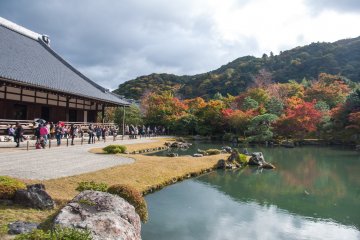
The Tenryuji is the main temple of the Rinzai Zen Buddhism sect of the same name and is located in the Arashiyama district in the northwest of the city of Kyoto. It is the most important Zen temple in the city and is a UNESCO World Heritage Site. The temple was built in 1339 by Shogun Ashikaga Takauji, who dedicated it to the recently deceased Emperor Go-Daigo. Both men were former allies until Takauji rebelled against the emperor in the struggle for supremacy in Japan. The temple should pacify the spirit of the deceased. The buildings of Tenryuji have been repeatedly destroyed by fire over the centuries, so that the current complex largely dates from the Meiji period (1868-1912). In contrast, the surrounding garden, which was designed by the well-known master of gardening, Muso Soseki, is still almost entirely original. Especially in autumn, when the foliage of the trees there and the Arashiyama mountains visible behind them turn red and yellow, the Tenryuji and its garden are a popular destination.

The Arashiyama Bamboo Forest is one of the most popular attractions in Kyoto and is made up of numerous trails for visitors to enjoy. For the best photos, make sure to get here early in the morning as it gets crowded very quickly. It's not just the beauty of the bamboo that attracts people. The Arashiyama bamboo forest is one of the 100 most beautiful soundscapes in Japan, which are designated by the Japanese Ministry of the Environment. The sound of the rustling bamboo swaying in the wind is almost meditative. If you walk along the main street of Arashiyama, you will also pass Tenryuji Temple, one of the most beautiful Zen temples in Kyoto. According to Japanese tradition, bamboo is a symbol of strength. Therefore, it often happens that a Buddhist temple or Shinto shrine has a small bamboo grove on its premises to ward off evil.